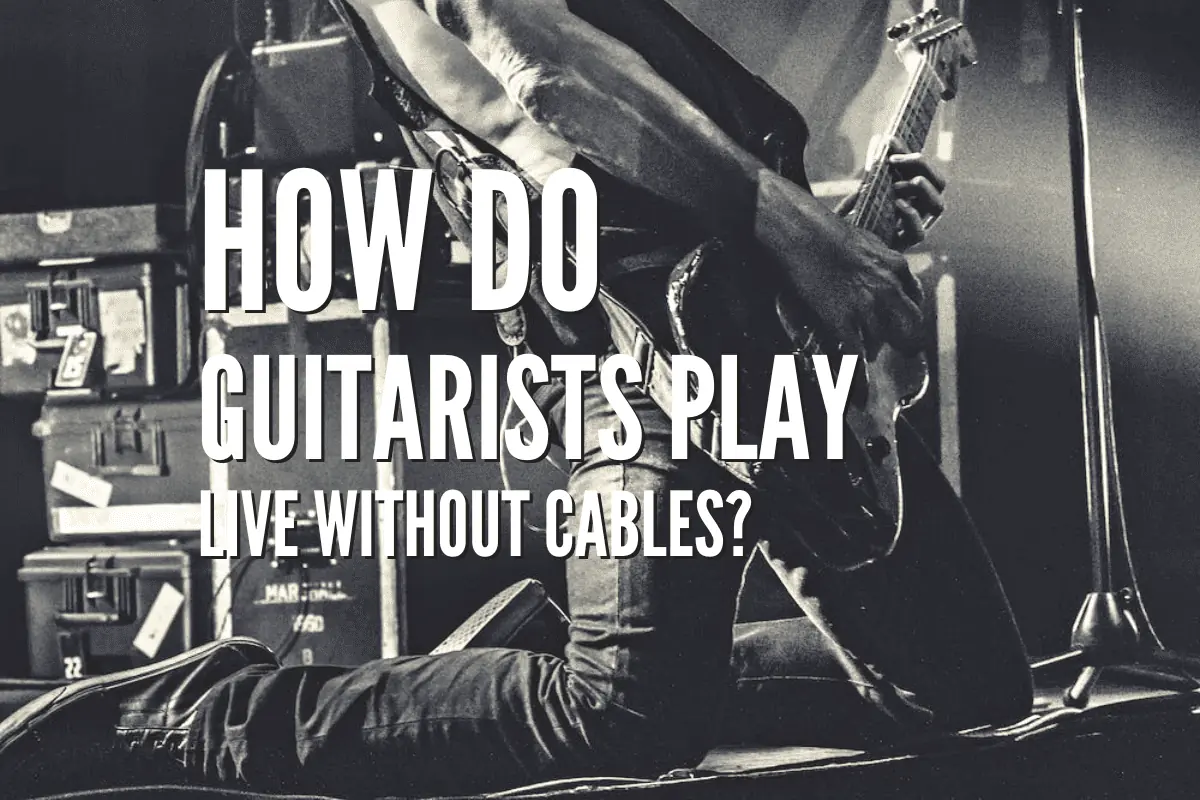If you’ve watched enough live performances, you might’ve noticed that more and more guitarists are now playing without cables. However, given that most electrical instruments used in these performances need to be connected to a power source to operate, how can these musicians hold hours-long shows without any cables in sight?
Guitarists play live without cables by using a wireless guitar system that allows the signal to be transmitted from the guitar to the amplifier without a cable. This helps the guitarists on the stage to get rid of the hassle of cables and play more freely.
Read on if you want to learn more about whether cables are necessary for live performances. Below, I’ll also take you through the differences between wired and wireless guitar systems and the pros and cons of each, so you’ll want to stick around until the end for this one.
Are Cables Necessary for Live Performances?

As thousands of wireless performances go to prove, cables aren’t necessary for live shows. With the rapid technological advancement that has taken place, wireless guitar systems have become so advanced and widely available that they’re quickly becoming the norm among performers.
Through wireless transmitters, musicians can move anywhere on stage without worrying about going too far or tripping over chunky cables. That’s why an increasing number of them are favoring these guitar systems.
Some performers still deem cables necessary due to their preferences, playing style, technical requirements, etc.
For these musicians, a cable connection may be preferred for its reliability, consistency, and great tonal characteristics. They might also favor the physical connection of a cable to an amplifier, as it can provide a more tactile and responsive playing experience.
The argument against the wireless system is that it loses tonal qualities on the transmission. Also, connection problems may occur with interference and other potential causes. That is why there are quite a lot of guitarists still going with cables.
In some performances – for example, in which a musician is stationary or using a paddleboard – a cable connection might be non-negotiable.
So, even though wireless performances are becoming more widespread, wired systems still boast reliability and practicality that can’t be replicated just yet.
Don’t get me wrong, wireless technology has advanced so much that issues like audio quality, latency, and interference have already been addressed and resolved. However, we’ve yet to achieve the point when wired systems become obsolete.
Wired vs. Wireless Guitar Systems

Since both wired and wireless guitar systems play a significant role in the performances we enjoy today, it’s safe to assume that both come with advantages and drawbacks that make it difficult to decide whether one option is inherently better.
Wired Guitar Systems: Pros and Cons
Wired guitar systems use cables to connect the guitar to the amplifier and the rest of the sound setup. One of their main advantages is that they typically provide a more reliable and consistent connection than their wireless counterparts; however, to make this info a bit easier to digest and compartmentalize, I’ll outline all of these pros and cons of wired guitar systems in the table below.
| Pros | Cons |
| Reliable and consistent connection | Limited mobility |
| Lowered chance of interference | Less expressive performance |
| It does not require batteries or charging | It can become a tripping hazard due to tangling |
| Less expensive than wireless systems |
Wireless Guitar Systems: Pros and Cons
On the other hand, wireless guitar systems allow the guitar signal to be transmitted wirelessly from the guitar to the amplifier or the rest of the sound system. They typically consist of two main components: a transmitter attached to the guitar and a receiver connecting to the amplifier and sound system.
The transmitter converts the guitar’s signal into a radio signal and then transmits it wirelessly to the receiver. This component is responsible for converting the radio signal back into an audio signal and sending it to the amplifier.
Professional musicians commonly use them during larger performances because they provide greater freedom and flexibility. However, to decide whether they’re worth the hype, read through the pros and cons outlined below.
| Pros | Cons |
| Greater mobility, they allow the musician to move freely on stage without being tethered to their amplifier or pedal board | Subject to interference from other devices, such as cell phones or other wireless equipment |
| More dynamic and engaging performance | More expensive than wired guitar systems |
| No tripping hazards on stage | Wireless guitar systems require batteries, which must be recharged and replaced regularly |
| May lose tonal qualities on the transmission |
Conclusion
As technology advances, more guitarists enjoy the freedom of wireless performances. There are three main methods that these performers use to get a cable-free experience. First, they benefit from modern wireless guitar systems, which minimize latency and interference while enhancing sound quality.
They might also be relying on tricks like miming over pre-recorded music or a live performance that a background guitarist is playing.
With all that said, there’s still a place in the music world for both wired and wireless guitar systems, and choosing between the two comes down to personal preference.
If you found this article useful, you may want to save this pin below to your Guitar board.

Recent Posts
Some guitarists insist on buying an expensive amplifier with their electric guitar. They assume that this is a must for every type of guitarist out there. However, in some situations, this isn’t...
Top 50 Free Realistic Guitar VST Plugins With Sound Examples
As technology has rapidly advanced in the recent decade, computers are stealing more and more roles from physical musical instruments and accessories. Nowadays, you do not need expensive amps,...

